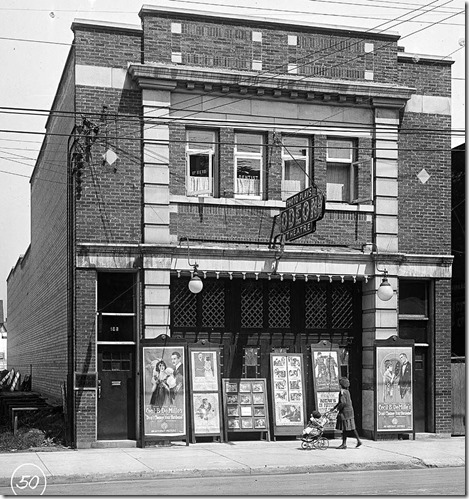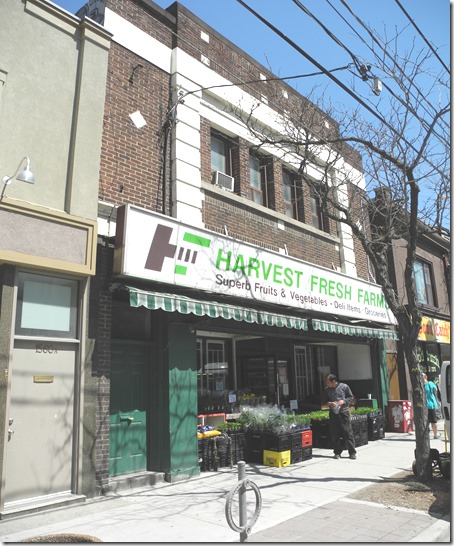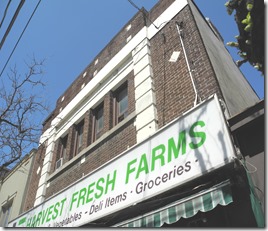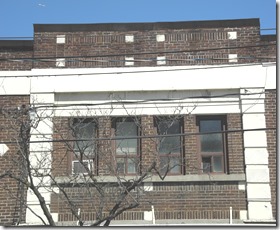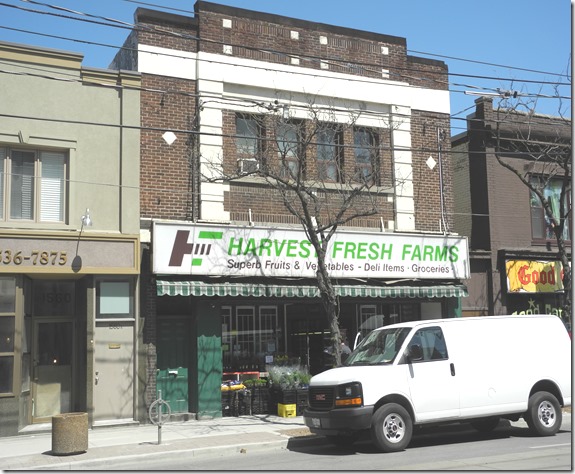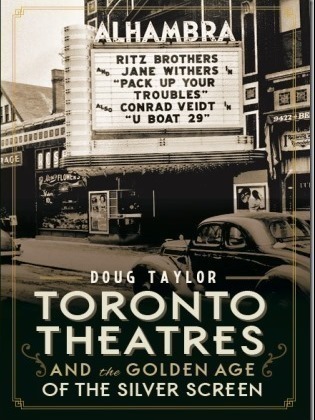The Odeon Theatre in 1919, located on Queen St. West in Parkdale. City of Toronto Archives.
The Odeon Theatre at 1558 Queen Street West, was located in the former village of Parkdale, annexed to the city in 1889. The theatre opened in 1919, a year after the end of the First World War. The film being screened in the 1919 photograph is “Don’t Change Your Wife,” starring a 20 year-old Gloria Swanson as a foolish wife.
Location of the Odeon Theatre at 1558 Queen Street West.
The year it opened, the Odeon undoubtedly provided much needed relief to the war-weary people of the community, creating an opportunity for them to forget the horrors of the news from the battle front of the previous year. The Odeon was likely the first theatre in the neighbourhood, as its competitor, the Parkdale Theatre, did not open until the spring of the following year. The Odeon Theatre had no connection to the British Odeon chain that began building theatres in the city in the 1940s. The word “Odeon” was derived from the name of an ancient Greek theatre, the Odeon Herodes Atticus, built in 435 BC in Athens. The theatre was located on the south side of the Acropolis, and still exists today. Its name became synonymous with entertainment.
The Odeon Theatre in Parkdale was a two-storey red brick building, with a residential apartment on the second floor. Its symmetrical facade was formal and dignified, reflecting more of the Edwardian period, as opposed to the newer trends that were to develop in the 1920s. Stone blocks that rose from the the ground-floor level to the lower cornice, created pilasters (faux-columns). They were an impressive addition to the facade. The upper cornice was plain, with a narrow parapet (wall) to increase the size of the south facade, when viewed from Queen Street.
The theatre’s auditorium possessed two aisles, with a centre section and aisles on either side. There were no side aisles, meaning that seats extended within inches of the east and west walls. It had a sloped floor, extending from where the screen was located to the rear wall. The back rows were elevated and accessed by stairs. The auditorium walls were plain with very few decorative details, although there were attractive designs surrounding the screen. When the theatre opened in 1919, it possessed a stage and space to accommodate a piano and a few musicians, as it offered vaudeville and live theatre, as well as silent movies.
A letter in the files at the Toronto Archives confirms that the theatre closed in October 1968. However, the building remains on Queen Street today, and contains a fruit market.
The site of the former Odeon Theatre during the summer of 2014.
The upper section of the facade of the Odeon on Queen West.
The fruit market on the site of the Odeon Theatre.
To view the Home Page for this blog: https://tayloronhistory.com/
To view previous blogs about movie houses of Toronto—historic and modern
Recent publication entitled “Toronto’s Theatres and the Golden Age of the Silver Screen,” by the author of this blog. The publication explores 50 of Toronto’s old theatres and contains over 80 archival photographs of the facades, marquees and interiors of the theatres. It relates anecdotes and stories of the author and others who experienced these grand old movie houses.
To place an order for this book:
Book also available in Chapter/Indigo, the Bell Lightbox Book Store and by phoning University of Toronto Press, Distribution: 416-667-7791
Theatres Included in the Book:
Chapter One – The Early Years—Nickelodeons and the First Theatres in Toronto
Theatorium (Red Mill) Theatre—Toronto’s First Movie Experience and First Permanent Movie Theatre, Auditorium (Avenue, PIckford), Colonial Theatre (the Bay), the Photodome, Revue Theatre, Picture Palace (Royal George), Big Nickel (National, Rio), Madison Theatre (Midtown, Capri, Eden, Bloor Cinema, Bloor Street Hot Docs), Theatre Without a Name (Pastime, Prince Edward, Fox)
Chapter Two – The Great Movie Palaces – The End of the Nickelodeons
Loew’s Yonge Street (Elgin/Winter Garden), Shea’s Hippodrome, The Allen (Tivoli), Pantages (Imperial, Imperial Six, Ed Mirvish), Loew’s Uptown
Chapter Three – Smaller Theatres in the pre-1920s and 1920s
Oakwood, Broadway, Carlton on Parliament Street, Victory on Yonge Street (Embassy, Astor, Showcase, Federal, New Yorker, Panasonic), Allan’s Danforth (Century, Titania, Music Hall), Parkdale, Alhambra (Baronet, Eve), St. Clair, Standard (Strand, Victory, Golden Harvest), Palace, Bedford (Park), Hudson (Mount Pleasant), Belsize (Crest, Regent), Runnymede
Chapter Four – Theatres During the 1930s, the Great Depression
Grant ,Hollywood, Oriole (Cinema, International Cinema), Eglinton, Casino, Radio City, Paramount, Scarboro, Paradise (Eve’s Paradise), State (Bloordale), Colony, Bellevue (Lux, Elektra, Lido), Kingsway, Pylon (Royal, Golden Princess), Metro
Chapter Five – Theatres in the 1940s – The Second World War and the Post-War Years
University, Odeon Fairlawn, Vaughan, Odeon Danforth, Glendale, Odeon Hyland, Nortown, Willow, Downtown, Odeon Carlton, Donlands, Biltmore, Odeon Humber, Town Cinema
Chapter Six – The 1950s Theatres
Savoy (Coronet), Westwood
Chapter Seven – Cineplex and Multi-screen Complexes
Cineplex Eaton Centre, Cineplex Odeon Varsity, Scotiabank Cineplex, Dundas Square Cineplex, The Bell Lightbox (TIFF)
